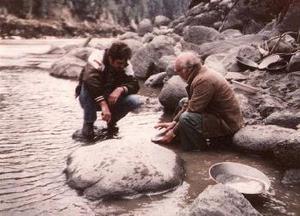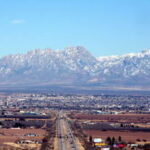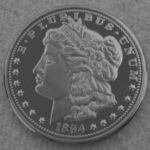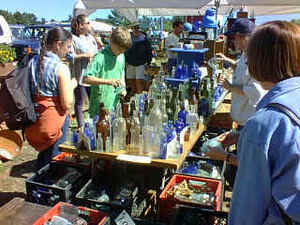I recently spent about a month in Alamogordo, New Mexico and I have to admit that at least a couple of times I caught myself daydreaming about what it must have been like to have been a prospector during the old west. Alamogordo didn’t hit it big with gold per se, but it experienced brisk business with silver and other minerals during a time when the west was still wild and one man’s claim could turn into another man’s dream if he wasn’t quick enough on the draw.
There are several locations around Alamogordo that were big mining towns that grew up overnight and faded away just as fast when the gold ran its course or turned out to be nothing of value.
Beats the heck out of me whether there’s any gold in “them thar hills” anymore. But I know one thing, prospecting for gold may sound silly to some, but it’s got enough of a following to support a healthy niche industry for anyone who wants to give it a try.
So what’s the attraction? Well for starters consider thatone ounce gold nugget will bring $2,000 to $4,000 on the collectors market. Per a letter from the Department of Agriculture, no permit is needed for recreational gold panning and gold prospecting in the general national forest areas, provided no machinery is used. Our gold panning and prospecting maps show many national forests with gold sites.
Panning for Gold is Easier Than You Think. You don’t have to be out in the Klondike somewhere to search for the Mother Lode. The best places to pan are along creeks, particularly behind boulders where eddies form. Although “black sand” (magnetite) is difficult to separate from the gold, it’s a great indication that you’re in the right spot. Heck you know that small creek behind your house? That’s as good a place as any. (If there’s no small creek behind your house, let’s just fake it)
The great thing about panning for gold…as opposed to digging for gold….is that it doesn’t take a whole lot. As far as hobbies are concerned; panning for gold is pretty low maintenance. I’m proud to say that everything I ever learned about pannin’ for gold I learned on the internet. Check out www.explorenorth.com and remember to keep your voice down when you strike it rich…
– Find a pan – anything with sloping sides will work.
– Fill your pan with sand and/or gravel.
– Dip your pan into the creek, or pour water into the pan. Shake the pan in a sideways, back-and-forth manner. The gold will now start to settle to the bottom of the pan.
– After a couple of minutes of shaking, pick out the bigger rocks that are getting separated (make sure than you don’t throw away any nuggets!)
– Tilt your pan away from you a bit and start letting gravel fall out. Remember, the gold is rapidly settling to the bottom of the pan now. Add water as necessary to keep a good “soupy” gravel mixture – it helps the gold settle.
– Keep tilting the pan more and more, and letting the gravel on top fall over the side. The bottom of the pan should always be lower than the lip of the pan, though, or the gold will fall out.
– As you get to the last bit of sand in your pan, adding a circular motion to your shaking will make the gold separation more obvious – not more effective, but more fun to watch.
– The last bit of sand takes care, and is the slowest part – as long as you don’t tip your pan too far, though, the gold will stay in the pan.
– The traditional declaration of success is “Bonanza!” Get a small glass container. Put your gold into the container – it will stick to your finger in the pan, and then wash it off into the container. Display the container on your mantel to impress the neighbors!
The above mentioned tips did not yield any gold. But I sure did get a sore back. Maybe the river we were panning in was too big. Perhaps you’ve heard of it – it’s called the Rio Grande.
Well pardner, rivers aren’t the only place to come down with gold fever, if you don’t mind a little digging. Most of the area you will want to hunt will be reasonably flat with exposed bed rock here and there. You’ll want to pack a pick, a shovel and metal detector. Quite often, there will be steep banks of reddish gravel around the flat area on at least one side. These banks can be two or three hundred feet high. This is the ore that was being mined. Take a close look at the gravel in the banks so you will recognize it later. If you run your detector over the stuff, you will probably find many hot rocks. Usually the bottom two or three feet had the best gold and the old timers sometimes just washed the rest into the drainage because there wasn’t enough gold to pay for the wear and tear on their sluice boxes. There had to be some place for the water and tailings to drain out of the digs. The mine could be open on one side or there may be one or more tunnels. If there is a tunnel, the miners often put their sluice in it.
Let’s take a closer look at the “reasonably flat area”. In the typical mine you will usually see some stunted trees eking out an existence by sinking their roots into bed rock cracks and some trees that enjoy a better life in areas where the gravel or dirt covers the bed rock. There are often many piles of rocks that were either too large to move or would cause too much damage if allowed to go through the sluice box.
In general, the best places to look are on bed rock or where dirt or other material appears to be shallow enough that any gold on bed rock is in range of your detector.
Now, you won’t be able to find these areas without help. So, if you’re on a schedule and a budget, you may just want to cut to the chase and purchase a gold map. Gold maps tell you how to pan, where to look in a streambed and how to tell fool’s gold from real gold. You can quickly learn to pan by following the instructions on your map. Some people like to pan for gold at public rights of way where bridges cross gold-bearing streams. Treasure hunters metal detect for coins at the rural schools and churches.
Check out www.goldmaps.com for good deals on gold maps. (I’m not quite sure why more people just don’t buy these things. They pretty much come with an “X” to mark the spot.
Seriously though, in the sprit of adventure and the fun that searching for gold invariably brings, most gold maps can only give you an idea of where gold may be found. Anybody claiming more than that is laughing all the way to the bank with your money.
For the record, a streak of gold mines and gold prospecting sites extends from near Montgomery, Alabama to WashingtonD.C. The gold was placed there when Africa overrode North America about 250 million years ago. North Carolina, South Carolina, Georgia, Virginia and Alabama have many gold mines and prospecting sites. These states were our main source of gold for 45 years before the California gold discovery. In 1837, the US Government established gold coin mints in Georgia and North Carolina, rather than transport the raw gold to the Philadelphia Mint.
Who knows — there may be gold right under your finger tips. If you’re looking for a hobby or a great way to meet people (there are plenty of “prospecting and panning” clubs across the US) then digging for gold may be just what you need.






